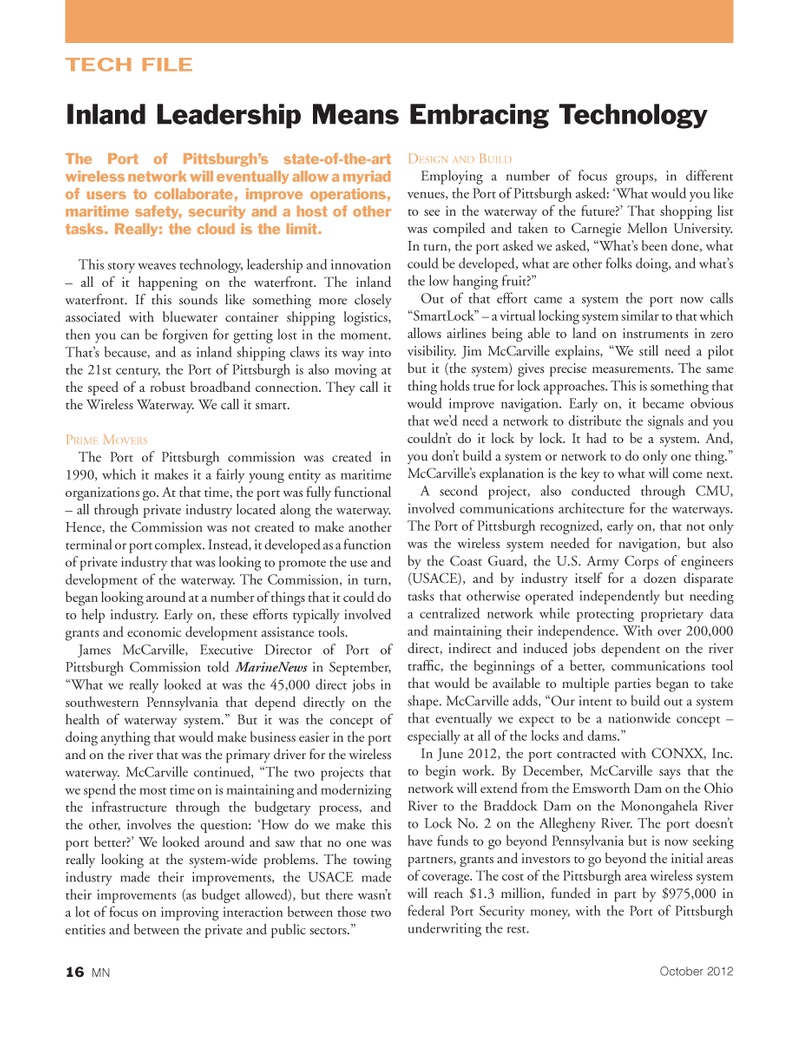
Page 16: of Marine News Magazine (October 2012)
Year in Review & Leadership
Read this page in Pdf, Flash or Html5 edition of October 2012 Marine News Magazine
The Port of Pittsburgh?s state-of-the-art wireless network will eventually allow a myriad of users to collaborate, improve operations, maritime safety, security and a host of other tasks. Really: the cloud is the limit.This story weaves technology, leadership and innovation ? all of it happening on the waterfront. The inland waterfront. If this sounds like something more closely associated with bluewater container shipping logistics, then you can be forgiven for getting lost in the moment. That?s because, and as inland shipping claws its way into the 21st century, the Port of Pittsburgh is also moving at the speed of a robust broadband connection. They call it the Wireless Waterway. We call it smart. PRIME MOVERS The Port of Pittsburgh commission was created in 1990, which it makes it a fairly young entity as maritime organizations go. At that time, the port was fully functional ? all through private industry located along the waterway. Hence, the Commission was not created to make another terminal or port complex. Instead, it developed as a function of private industry that was looking to promote the use and development of the waterway. The Commission, in turn, began looking around at a number of things that it could do to help industry. Early on, these efforts typically involved grants and economic development assistance tools. James McCarville, Executive Director of Port of Pittsburgh Commission told MarineNews in September, ?What we really looked at was the 45,000 direct jobs in southwestern Pennsylvania that depend directly on the health of waterway system.? But it was the concept of doing anything that would make business easier in the port and on the river that was the primary driver for the wireless waterway. McCarville continued, ?The two projects that we spend the most time on is maintaining and modernizing the infrastructure through the budgetary process, and the other, involves the question: ?How do we make this port better?? We looked around and saw that no one was really looking at the system-wide problems. The towing industry made their improvements, the USACE made their improvements (as budget allowed), but there wasn?t a lot of focus on improving interaction between those two entities and between the private and public sectors.? DESIGN AND BUILDEmploying a number of focus groups, in different venues, the Port of Pittsburgh asked: ?What would you like to see in the waterway of the future?? That shopping list was compiled and taken to Carnegie Mellon University. In turn, the port asked we asked, ?What?s been done, what could be developed, what are other folks doing, and what?s the low hanging fruit?? Out of that effort came a system the port now calls ?SmartLock? ? a virtual locking system similar to that which allows airlines being able to land on instruments in zero visibility. Jim McCarville explains, ?We still need a pilot but it (the system) gives precise measurements. The same thing holds true for lock approaches. This is something that would improve navigation. Early on, it became obvious that we?d need a network to distribute the signals and you couldn?t do it lock by lock. It had to be a system. And, you don?t build a system or network to do only one thing.? McCarville?s explanation is the key to what will come next. A second project, also conducted through CMU, involved communications architecture for the waterways. The Port of Pittsburgh recognized, early on, that not only was the wireless system needed for navigation, but also by the Coast Guard, the U.S. Army Corps of engineers (USACE), and by industry itself for a dozen disparate tasks that otherwise operated independently but needing a centralized network while protecting proprietary data and maintaining their independence. With over 200,000 direct, indirect and induced jobs dependent on the river traf c, the beginnings of a better, communications tool that would be available to multiple parties began to take shape. McCarville adds, ?Our intent to build out a system that eventually we expect to be a nationwide concept ? especially at all of the locks and dams.? In June 2012, the port contracted with CONXX, Inc. to begin work. By December, McCarville says that the network will extend from the Emsworth Dam on the Ohio River to the Braddock Dam on the Monongahela River to Lock No. 2 on the Allegheny River. The port doesn?t have funds to go beyond Pennsylvania but is now seeking partners, grants and investors to go beyond the initial areas of coverage. The cost of the Pittsburgh area wireless system will reach $1.3 million, funded in part by $975,000 in federal Port Security money, with the Port of Pittsburgh underwriting the rest. TECH FILEInland Leadership Means Embracing Technology 16 MNOctober 2012MNOct2012 Layout 1-17.indd 16MNOct2012 Layout 1-17.indd 1610/2/2012 9:32:54 AM10/2/2012 9:32:54 AM

 15
15

 17
17
